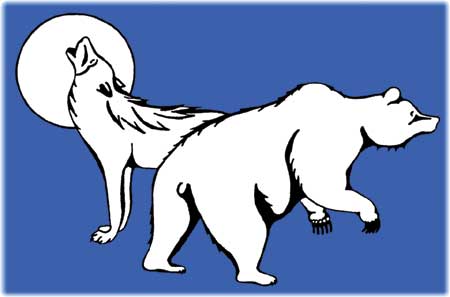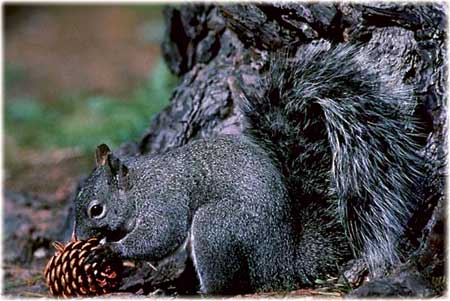|
THREATENED SPECIES
Exponential Extinction?
Fossil records reveal that the current
rate of species extinction is the fastest in history. The status of rare
and endangered species is always on the forefront of environmental
issues in any ecosystem. As human impacts jeopardize rare species, the
increase in the extinction rate echoes our own rapid population growth.
Today, habitat loss is the prime threat to species at risk of
extinction, but poaching and invasive non-native species also cause
numbers to dwindle. Research, in places such as national parks, helps us
recognize problems which rare species face and prevent the loss of these
valued plants and animals.
North Cascades National Park, adjacent
national forests and wilderness areas, and other northwestern national
parks provide critical habitat for a number of species facing
extinction. Since the passage of the Endangered Species Act in 1973,
more than a thousand species have been listed for the special
protections the act provides. One positive result has been the recovery
of Peregrine Falcon and Bald Eagle populations, due in part to the
banning of the pesticide DDT.
Before a species is placed on the U.S. Fish
and Wildlife Service's federal list of endangered and threatened
wildlife and plants, a strict legal process determines the current
status of the species. An endangered species is one in danger of
extinction throughout a significant portion of its range. A
threatened species is one likely to become endangered in the
foreseeable future. The federal listing also records plants and animals
that are candidates (proposed additions) for the list. In addition to
the federal listing, Washington State Department of Fish and Wildlife
maintains state specific listings.
endangered.fws.gov
wdfw.wa.gov/wlm/diversty/soc/concern.htm
Threatened And Endangered Species In North
Cascades National Park
Northern Spotted Owl
Federal: Threatened
State: Endangered
This owl's body measures about 1.5 feet with a
wing span of 4 feet. It relies on old-growth forests, nesting mostly in
trees more than 200 years old and is a rare sight in the
park.
Causes of decline: Habitat loss
and (in recent years) competition with Barred Owls.
Bull Trout
Federal: Threatened
State: Threatened
This is the fish with the polka dot back. Bull
trout have white trim around each fin and no black on the dorsal fin. It
prefers cold waters with temperatures just above freezing. Females build
nests in the gravel and lay up to 5,000 eggs. Added to the endangered
species list in 1997; bull trout are extinct in some previously
inhabited lakes and streams.
Causes of decline: Habitat loss
and decreased water quality.
Gray Wolf
Federal: Endangered
State: Endangered
The long legs, large feet and narrow chests of
gray wolves allow them to move quickly through snow and thick shrubbery.
Wolves live in open forests and tundra in families or packs.
Causes of decline: Habitat loss
and efforts by some to eradicate these predators.

Grizzly Bear
Federal: Threatened
State: Endangered
The grizzly bear can be difficult to
distinguish in the wild from the black bear. Grizzly bears usually have
a shoulder hump, a dished face and long, straight claws on their
forefeet. The grizzly often rears on its hind legs to get a better view
of the surroundings. During the winter months it hibernates in dens or
caves. In summer, grizzly bears seek out river cooridors and high alpine
shrubby areas. They require large territories to roam, breed only once
every three to five years and produce a litter of one to two cubs.
Grizzlies are very rarely seen in the North Cascades.
Causes of decline: Habitat loss
and historic hunting.
Canada Lynx
Federal: Threatened
State: Threatened
Lynx have large padded feet for snow travel
and heavy coats for cold weather with long black hair on the tips of the
ears. When snowshoe hares are abundant (about every 10 years) the lynx
produce larger litters and when the hares are scarce, this cat's
population declines. A small number of lynx live in the Pasayten
Wilderness east of North Cascades NPSC.
Causes of decline: Trapping,
hunting and reduction of prey.
Marbled Murrelet
Federal: Threatened
State: Threatened
This robin-sized diving sea bird has wings
that allow it to fly underwater. Marbled murrelets lay only one egg each
season. The parents travel to and from the ocean to bring food back for
their chick. This sea bird migrates from the sea to nest high in the
trees of old-growth forests. It has been sighted near the west boundary
of the park.
Causes of decline: Habitat loss
and marine fish declines.
Bald Eagle
Federal: Threatened
State: Threatened
As adults these large raptors can grow to 3
feet tall with wingspans of more than 7 feet. Adults have brown bodies,
yellow beaks and white heads and tails. The Skagit River Watershed,
which drains from the park, supports one of the largest wintering
populations of bald eagles within the contiguous United
States.
Cause of decline: Toxins from
pesticides that accummulate in fish and mammal food sources.
Western Gray Squirrel
Federal: Species of concern
State: Threatened
A bushy tail, as long as the body, is used for
balance when jumping. The squirrel lives in wooded areas, building nests
of sticks and shredded bark about 20 feet above the forest floor. A
small population lives in the Stehekin Valley.
Causes of decline: Habitat
loss.
Fisher
Federal: Species of concern
State: Endangered
This carnivore belongs to the weasel family,
but can grow to over three feet and weigh over 30 pounds. These elusive
hunters once occurred throughout Washington, however, extensive surveys
have been unable to confirm the existence of a population in the state.
Sightings of fishers are very rare in the park.
Causes of decline: Habitat loss
and trapping.
www.nps.gov/noca/treas.htm


Western Gray Squirrel
|
Threatened Gray Squirrels Get
Attention
Though we may take squirrels in our
neighborhoods and forests for granted, there's nothing common about the
western gray squirrel. While this native of mixed conifer and oak
forests was once widespread over nearly half of Washington, it now
survives in only three small, isolated populations. The western gray
squirrel's situation is so dire that it is an unlucky member of
Washington State's threatened species list.
One remnant population of western grays lives
in the Stehekin Valley of Lake Chelan National Recreation Area, managed
by the National Park Service. This valley's ponderosa pines provide the
squirrel's required banquet of conifer seeds, mushrooms, insects, and
berries, plus tall trees for safe resting and nesting. In times of
plenty, the squirrels cache seeds for winter. Seeds not retrieved can
grow to renew the forest and provide food and shelter for other members
of the community.
Despite their protection by the park and the
state's Endangered Species Act, western gray squirrel numbers are
probably declining. Several characteristics make them susceptible to
extinction. They rely on increasingly rare large, old, conifer forests,
traveling in the tree tops to move around and to escape from predators.
Their small and isolated populations are sensitive to human disturbance.
High susceptibility to disease and a low reproductive rate (one litter
per year) mean slow recovery from population reductions. These are not
the rapidly spreading eastern gray squirrels introduced to the Northwest
by humans and now abundant in some developed areas of
Washington.
Scientists from North Cascades National Park
propose a three year study with cooperators (University of Washington
and United States Geological Survey) to investigate the causes of the
alarming drop in population numbers in Washington. If funded,
researchers will study the squirrels and their habitat in the Stehekin
Valley in relation to management practices in the area. By searches on
the ground and tracking radio collared squirrels, scientists will gather
data on the numbers and health of this isolated group, their foraging
and nesting activities and their reproductive status. This information
will help identify what land managers need to do to maintain a viable
population of western gray squirrels in the Stehekin Valley and maybe in
other parts of Washington too.
|
